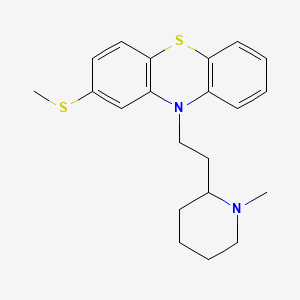Attribution Statement: LactMed is a registered trademark of the U.S. Department of Health and Human Services.
NCBI Bookshelf. A service of the National Library of Medicine, National Institutes of Health.
Drugs and Lactation Database (LactMed®) [Internet]. Bethesda (MD): National Institute of Child Health and Human Development; 2006-.
CASRN: 50-52-2

Drug Levels and Effects
Summary of Use during Lactation
Because there is no published experience with thioridazine during breastfeeding, an alternate drug may be preferred, especially while nursing a newborn or preterm infant.
Drug Levels
Maternal Levels. Relevant published information was not found as of the revision date.
Infant Levels. Relevant published information was not found as of the revision date.
Effects in Breastfed Infants
Relevant published information was not found as of the revision date.
Effects on Lactation and Breastmilk
Phenothiazines cause galactorrhea in 26 to 40% of female patients.[1,2] Hyperprolactinemia appears to be the cause of the galactorrhea.[3-6] There is some evidence that thioridazine increases serum prolactin to a greater extent than other phenothiazines.[7] The hyperprolactinemia is caused by the drug's dopamine-blocking action in the tuberoinfundibular pathway.[8] The prolactin level in a mother with established lactation may not affect her ability to breastfeed.
Alternate Drugs to Consider
References
- 1.
- Polishuk WZ, Kulcsar S. Effects of chlorpromazine on pituitary function. J Clin Endocrinol Metab. 1956;16:292–3. [PubMed: 13286329]
- 2.
- Hooper JH Jr, Welch VC, Shackelford RT. Abnormal lactation associated with tranquilizing drug therapy. JAMA. 1961;178:506–7. [PubMed: 14448766]
- 3.
- Turkington RW. Prolactin secretion in patients treated with various drugs: Phenothiazines, tricyclic antidepressants, reserpine, and methyldopa. Arch Intern Med. 1972;130:349–54. [PubMed: 4560178]
- 4.
- Turkington RW. Serum prolactin levels in patients with gynecomastia. J Clin Endocrinol Metab. 1972;34:62–6. [PubMed: 5061776]
- 5.
- Beumont PJ, Gelder MG, Friesen HG, et al. The effects of phenothiazine on endrocrine function: I Patients with inappropriate lactation and amenorrhoea. Br J Psychiatry. 1974;124:413–9. [PubMed: 4151788]
- 6.
- Meltzer HY, Fang VS. The effect of neuroleptics on serum prolactin in schizophrenic patients. Arch Gen Psychiatry. 1976;33:279–86. [PubMed: 1259521]
- 7.
- Goodnick PJ, Rodríguez L, Santana O. Antipsychotics: Impact on prolactin levels. Expert Opin Pharmacother. 2002;3:1381–91. [PubMed: 12387684]
- 8.
- Maguire GA. Prolactin elevation with antipsychotic medications: Mechanisms of action and clinical consequences. J Clin Psychiatry. 2002;63 Suppl 4:56–62. [PubMed: 11913677]
Substance Identification
Substance Name
Thioridazine
CAS Registry Number
50-52-2
Drug Class
Breast Feeding
Lactation
Milk, Human
Antipsychotic Agents
Phenothiazines
Disclaimer: Information presented in this database is not meant as a substitute for professional judgment. You should consult your healthcare provider for breastfeeding advice related to your particular situation. The U.S. government does not warrant or assume any liability or responsibility for the accuracy or completeness of the information on this Site.
- User and Medical Advice Disclaimer
- Drugs and Lactation Database (LactMed) - Record Format
- LactMed - Database Creation and Peer Review Process
- Fact Sheet. Drugs and Lactation Database (LactMed)
- Drugs and Lactation Database (LactMed) - Glossary
- LactMed Selected References
- Drugs and Lactation Database (LactMed) - About Dietary Supplements
- Breastfeeding Links
- PubChem SubstanceRelated PubChem Substances
- PubMedLinks to PubMed
- Thioridazine - Drugs and Lactation Database (LactMed®)Thioridazine - Drugs and Lactation Database (LactMed®)
- XPNPEP2 [Oryctolagus cuniculus]XPNPEP2 [Oryctolagus cuniculus]Gene ID:100339097Gene
- PI4K2A phosphatidylinositol 4-kinase type 2 alpha [Equus caballus]PI4K2A phosphatidylinositol 4-kinase type 2 alpha [Equus caballus]Gene ID:100070680Gene
- CHADL chondroadherin like [Homo sapiens]CHADL chondroadherin like [Homo sapiens]Gene ID:150356Gene
Your browsing activity is empty.
Activity recording is turned off.
See more...
